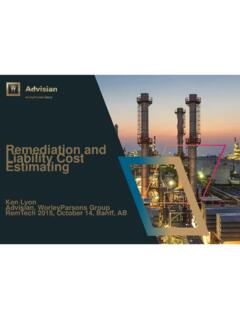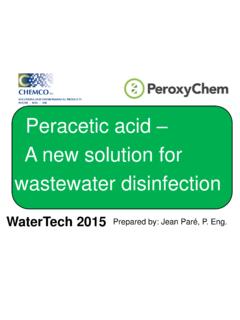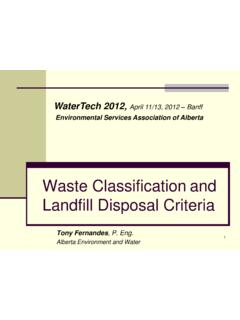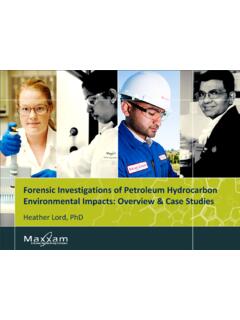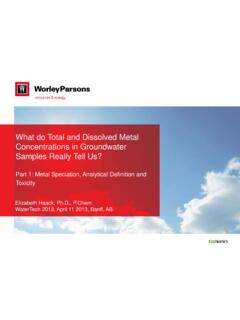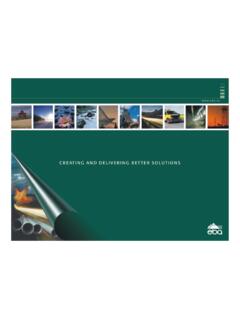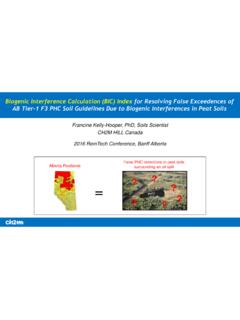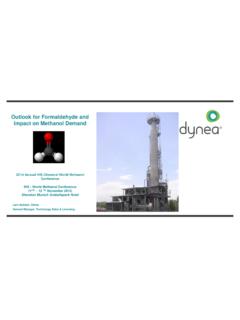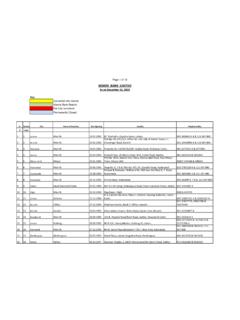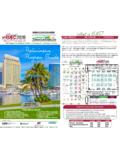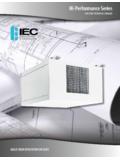Transcription of SUCCESSFUL LNAPL REMOVAL USING AIR SPARGE/ SOIL …
1 SUCCESSFUL LNAPL REMOVAL USING AIR SPARGE/ SOIL VAPOUR EXTRACTION TECHNOLOGY Jamie Natusch, , Manager Remediation Services Lynda Smithard, , Senior Remediation Engineer INTRODUCTION The application of Air Sparging (AS) technology coupled with Soil Vapour Extraction (SVE) for the recovery and remediation of Light Non-Aqueous Phase Liquid ( LNAPL ) hydrocarbons presents a number of challenges. AS applicability is governed mainly by geo/hydrogeologic conditions and contaminant type and distribution. It is typically not applied to mobile- LNAPL plumes where the enhanced risk of product migration is not manageable.
2 However, under suitable site conditions and design provisions, accurate LNAPL plume control and associated risk-management can be achieved to enable a high-impact approach towards contaminant mass REMOVAL and site remediation. This paper presents the detailed design and implementation of a fast-tracked AS/SVE remediation program successfully completed during 2004-2005 at a large commercial development property in Surrey, BC. Summaries of the site conditions and URS s remedial options evaluation that supported the program are presented as background.
3 Although AS technology is well-established, it has been applied with varying degrees of success as the physical, chemical and microbial processes responsible for removing contaminants remain poorly understood and can be difficult to evaluate. Engineering design and implementation of these systems is dependent on empirical knowledge and experience. SUCCESSFUL air sparging requires continuous review and refinement of optimal system and contaminant mass transfer efficiencies. In this context, URS s paper evaluates the application of AS technology to the remediation of LNAPL hydrocarbons, with the aim of sharing lessons learned for future applications.
4 SITE DESCRIPTION The site is located adjacent to a major highway with surrounding mixed commercial and residential land use. Phased site investigations identified free phase ( LNAPL ) gasoline product, soil and groundwater contamination across four legal lots and extending beneath the highway. The contamination originated from a gasoline retail facility that operated at the site between 1962 and 1981 (the source site ). More recently the source site has been occupied by series of new and used car dealerships and currently forms part of a multi-site development plan that includes the other three impacted lots.
5 A Site Plan showing the layout of the site is presented as Figure 1. Site stratigraphy comprises surficial fill, underlain by a clay/silt layer from m below ground surface (bgs), and sand from > m bgs. Depths to groundwater vary across the site from m bgs, with an estimated zone of watertable fluctuation of approximately m. The localized groundwater aquifer is present within high permeability coarse sands and gravels. The average hydraulic conductivity at the site is Figure 1: Site Plan showing the approximate extents of dissolved phase and LNAPL contamination identified at the site.
6 X 10-4 m/s, and with an effective porosity of and an interpreted hydraulic gradient (m/m), groundwater flows at an approximate velocity of 34 m/year from the subject site towards the southeast for approximately 200 m before flowing south. SITE GEOCHEMISTRY A phased site investigation was conducted by a number of parties over a six-year period starting in 1998. URS completed the detailed site investigation in 2004 with the delineation of the LNAPL , soil and dissolved phase hydrocarbon plumes. The site investigations identified soil contamination in the vadose zone only in the source area.
7 Soil contamination in the saturated smear zone extended approximately 150 m hydraulically downgradient of the source area. In total, approximately 2,500 m3 of petroleum hydrocarbon contaminated soil existed over an area of 5,000 m2. Dissolved phase groundwater contamination extended approximately 240 m down hydraulic gradient of the former UST basin and pump islands and covered an approximate 10,000 m2 area. LNAPL was present beneath portions of the site and highway. The LNAPL plume, measured prior to the initiation of remedial activities, covered an approximate 1,200 m2 area with a maximum measured thickness of m in 2002.
8 The estimated volume of free phase LNAPL product in the vicinity of the site prior to remediation was approximately 30,000L. REMEDIAL OBJECTIVES The primary remedial objective for the site was the REMOVAL of the LNAPL source, to be supported by the adoption of risk assessment for the management of potential ecological and human health exposure risks associated with residual soil and dissolved phase groundwater contamination at the site. REMEDIAL OPTIONS EVALUATION Commercially, the primary factor in evaluating remediation options was an efficient timeline to completion to facilitate property development.
9 On this basis, technical assessment and cost-benefit analyses were conducted for the preliminary evaluation of a range of in-situ and ex situ technologies incorporating free and dissolved phase product recovery and unsaturated zone residual product recovery methods. Due to the extent of the LNAPL plume beneath the highway, ex situ approaches based on excavation and on/off-site treatment/disposal were eliminated and the following in situ technologies were short-listed for more detailed evaluation. Free Phase Product Recovery Product Skimming Pump and Treat Free Phase and Residual Product Recovery Soil Vapour Extraction (SVE) Multi-Phase Extraction (MPE) Unsaturated Zone Residual Product Recovery Bioventing Soil Vapour Extraction (SVE) Free and Dissolved Phase Recovery Pump and Treat with SVE Air Sparging with SVE All of these technologies, and variations/combinations of these, presented technically compatible solutions to site contamination and geo/hydrogeological conditions.
10 However, when assessed from a time and cost-benefit perspective, AS/SVE technology presented the most expeditious approach towards fast-tracked LNAPL remediation, with high-impact recovery potential. Yet, AS/SVE application also posed several key design/implementation challenges that had to be overcome to make it viable. The challenges URS faced in the design and operation of the system, and the solutions derived to overcome them are discussed in subsequent sections. AIR SPARGING/SVE TECHNOLOGY EVALUATION AS technology involves the injection of air/oxygen into a contaminated aquifer.
